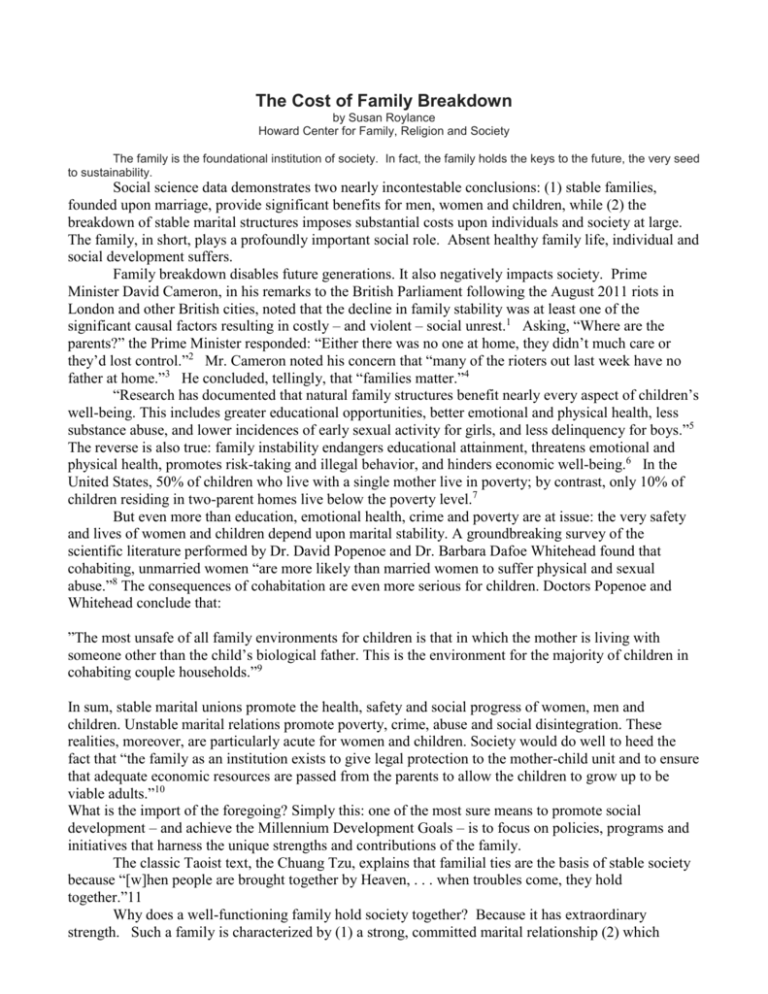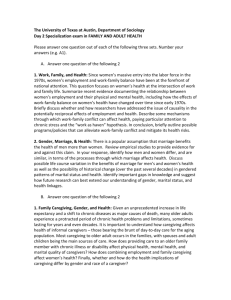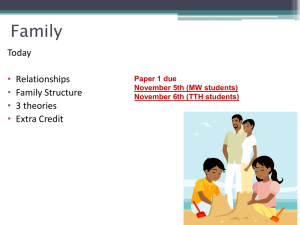HowardCenterFamilyReligionSociety
advertisement

The Cost of Family Breakdown by Susan Roylance Howard Center for Family, Religion and Society The family is the foundational institution of society. In fact, the family holds the keys to the future, the very seed to sustainability. Social science data demonstrates two nearly incontestable conclusions: (1) stable families, founded upon marriage, provide significant benefits for men, women and children, while (2) the breakdown of stable marital structures imposes substantial costs upon individuals and society at large. The family, in short, plays a profoundly important social role. Absent healthy family life, individual and social development suffers. Family breakdown disables future generations. It also negatively impacts society. Prime Minister David Cameron, in his remarks to the British Parliament following the August 2011 riots in London and other British cities, noted that the decline in family stability was at least one of the significant causal factors resulting in costly – and violent – social unrest.1 Asking, “Where are the parents?” the Prime Minister responded: “Either there was no one at home, they didn’t much care or they’d lost control.”2 Mr. Cameron noted his concern that “many of the rioters out last week have no father at home.”3 He concluded, tellingly, that “families matter.”4 “Research has documented that natural family structures benefit nearly every aspect of children’s well-being. This includes greater educational opportunities, better emotional and physical health, less substance abuse, and lower incidences of early sexual activity for girls, and less delinquency for boys.”5 The reverse is also true: family instability endangers educational attainment, threatens emotional and physical health, promotes risk-taking and illegal behavior, and hinders economic well-being.6 In the United States, 50% of children who live with a single mother live in poverty; by contrast, only 10% of children residing in two-parent homes live below the poverty level.7 But even more than education, emotional health, crime and poverty are at issue: the very safety and lives of women and children depend upon marital stability. A groundbreaking survey of the scientific literature performed by Dr. David Popenoe and Dr. Barbara Dafoe Whitehead found that cohabiting, unmarried women “are more likely than married women to suffer physical and sexual abuse.”8 The consequences of cohabitation are even more serious for children. Doctors Popenoe and Whitehead conclude that: ”The most unsafe of all family environments for children is that in which the mother is living with someone other than the child’s biological father. This is the environment for the majority of children in cohabiting couple households.”9 In sum, stable marital unions promote the health, safety and social progress of women, men and children. Unstable marital relations promote poverty, crime, abuse and social disintegration. These realities, moreover, are particularly acute for women and children. Society would do well to heed the fact that “the family as an institution exists to give legal protection to the mother-child unit and to ensure that adequate economic resources are passed from the parents to allow the children to grow up to be viable adults.”10 What is the import of the foregoing? Simply this: one of the most sure means to promote social development – and achieve the Millennium Development Goals – is to focus on policies, programs and initiatives that harness the unique strengths and contributions of the family. The classic Taoist text, the Chuang Tzu, explains that familial ties are the basis of stable society because “[w]hen people are brought together by Heaven, . . . when troubles come, they hold together.”11 Why does a well-functioning family hold society together? Because it has extraordinary strength. Such a family is characterized by (1) a strong, committed marital relationship (2) which centers upon transmitting appropriate ethical, cultural and religious values to children (3) in an atmosphere that emphasizes the interconnectedness, complementarity and responsibilities of family members toward each other, members of the extended family, the community and the broader family of mankind. Such a family produces capable and well-socialized women, men and children – the necessary foundation for a stable and peaceful world. Some may object that this description is idealistic, religiously motivated and inapplicable to the complexities of the modern world. However appealing such skepticism may be to some, mounting research ratifies and confirms the importance of the well-functioning family. A treatise compiled by the United Nations University in 1995 at the conclusion of the 1994 International Year of the Family, for example, concluded that – even in situations of direst poverty – the single most important factor influencing social outcomes for individuals is whether they are members of a strong, stable family. As the authors concluded: “Children thriving in poor communities were statistically most likely to live in families characterized by traditional fireside family values; devoted mothers and fathers, happy marriages, and warm cooperative bonds with siblings, grandparents, other relatives and the broader community.”12 A 1997 American Medical Association study similarly found that the factor most “significantly related” to a decrease in risky adolescent behaviors was “the presence of connected, caring parents.”13 The researchers concluded that “one can only hope” that government at all levels will seek to “develop policies that support families.”14 __________________ The above information is from the Foreword by Richard G. Wilkins for our book, The Family and the MDGs, by Susan Roylance (2014). Endnotes: 1. “PM’s speech on the fightback after the riots,” Aug. 15, 2011, online at http://www.number10.gov.uk/news/pms-speech-on-the-fightback-after-the-riots 2. Id. 3. Id. 4. Id. 5. Craig H. Hart, Ph.D., “Combating the Myth that Parent’s Don’t Matter,” at 3 (address delivered at the World Congress of Families II, Geneva, Switzerland) (available on-line at www.worldcongress.org). 6. Id. 7. Id. 8. David Popenoe and Barbara Dafoe Whitehead, “Should We Live Together? What Young Adults Need to Know about Cohabitation Before Marriage,” at 7 (The National Marriage Project, Rutgers University 1999). 9. Id. at 8. 10. Dr. Maria Sophia Aguirre, “Family Economics and the Information Society: How are They Affecting Each Other?” at 12 (paper presented at the World Congress of Families II, Geneva, Switzerland) (available on-line at www.worldcongress.org). 11. The Chuang Tzu: A New Complete Translation of the Classic Taoist Text (Martin Palmer and Elizabeth Breuilly, trans. 1996). 12. Marian F. Zeitlin, Ratna Megawangi, Ellen M. Kramer, Nancy D. Colletta, E.D. Babatunde, and David Garman, Strengthening the Family: Implications for International Development (United Nations University Press 1995) at 1. 13. “Protecting adolescents from harm: findings from the National Longitudinal Study,” The Journal of the American Medical Association, Vol. 278, No. 10 (Sept. 10, 1997) at 864. 14. Id. __________ Social science data demonstrates two nearly incontestable conclusions: (1) stable families, founded upon marriage, provide significant benefits for men, women and children, while (2) the breakdown of stable marital structures imposes substantial costs upon individuals and society at large. The family, in short, plays a profoundly important social role. Absent healthy family life, individual and social development suffers. Because of the connection between well-functioning families and well-functioning societies, this book – which examines how the family can be engaged to achieve the Millennium Development Goals (MDGs) – is a welcome contribution. Indeed, the Secretary General (as noted on the title page) has urged governments, intergovernmental entities and civil society to “focus on the family” in developing strategies to meet the millennium development targets. The information presented in this book provides much-needed guidance for this vitally important strategic endeavor. Governments, intergovernmental bodies and members of civil society might consider the following data, which demonstrates that healthy families benefit individual and social progress while family breakdown imposes costs. I urge all stakeholders within the international policy arena to consider what the authors of this volume now propose: that the unique contributions of the family – or “family capital” – should be recognized and utilized to achieve the Millennium Development Goals. I. THE BENEFITS OF STABLE FAMILY LIFE A growing body of research suggests that the family is indispensable to the welfare of society and to the individuals that comprise it.1 Much recent research, in fact, shows that stable family life has significant benefits for children and their parents. 1. Benefits flowing to children and youth According to one scholar, marriage is “by far the most emotionally stable and economically secure arrangement for child rearing.”2 Research, in fact, indicates that – for children – nothing compares to a solid, stable marriage between their biological parents. a. Education. Studies consistently show that children in two-parent families are significantly less likely to drop out of school than children in a one-parent family.3 Some studies have found that the likelihood of dropping out more than doubles for children in single-parent households.4 b. Poverty reduction. Children raised outside marriage are more likely to be raised in poor economic conditions.5 These children suffer not only from economic deprivations, but also from a lack of parental attention and high rates of residential relocation, all of which disadvantage the child’s development.6 c. Crime prevention. Dual parenting plays a critical role in developing law-abiding citizens. As one researcher noted, “the single most important factor in determining if a male will end up incarcerated later in life is . . . whether or not he has a father in the home.”7 d. Healthy socialization. Marriage is an unequaled institution for fostering healthy socialization. “[C]hildren of divorce do not accept monitoring or supervision from live-in partners nearly as much as they do from married parents.”8 Young adults in single-parent households are also more likely to give birth out of wedlock, and are more likely to be out of both school and the labor force.9 2. Benefits flowing to adults. The benefits of family life are equally significant for adults. These benefits, moreover, do not flow from some natural selection process in which healthy, strong, bright and charismatic people are the most likely to marry and, therefore, the most likely to profit from the union. “Married people do not simply appear to be better off than unmarried people; rather, marriage changes people in ways that produce such benefits.”10 a. Physical health. There is a positive – and multi-factored – causal relationship between marriage and physical health. Married men and women live longer than non-married individuals.11 These statistics are especially significant for unmarried men who “face higher risks of dying than married men, regardless of their marital history.”12 Moreover, married persons, both men and women, are less likely to engage in risk-taking behavior.13 Perhaps even more importantly, researchers believe that marriage actually encourages responsible, healthy behaviors.14 Finally, and perhaps flowing from all of the above, research indicates that married individuals suffer less from illness and disease and are better off than their never-married or divorced counterparts when they do fall ill.15 b. Mental and emotional health. “The psychological well-being of the married is substantially better than that of the unmarried.”16 “Married people have lower rates of depression and suffer significantly less from any psychiatric disorder than their divorced, never-married, or cohabitating counterparts.”17 Married individuals, furthermore, are less likely to be admitted to a public mental health institution,18 less likely to be admitted to a psychiatric clinic and more likely to cope with psychologically stressful events.19 Marriage has also been linked with reports of increased happiness, life satisfaction, and overall occurrence of positive emotions.20 Indeed, “no part of the unmarried population – separated, divorced, widowed, or never married – describes itself as being so happy and contented with life as the married.”21 c. Social productivity. Marriage has a significant (but often overlooked) impact on social productivity. Marriage, to take but one example, has proven to be a positive factor in the workplace. One study, in fact, has indicated that married men logged more than double the hours of cohabiting single men.22 Yet another noted scholar has concluded that the “salutary role” of “father, mother, and their children living together and caring for their individual and collective progress” provides the essential foundation for personal liberty and an efficient market economy.23 II. THE COSTS OF FAMILY INSTABILITY Family breakdown disables future generations. It also negatively impacts society. Prime Minister David Cameron, in his remarks to the British Parliament following the August 2011 riots in London and other British cities, noted that the decline in family stability was at least one of the significant causal factors resulting in costly – and violent – social unrest.24 Asking, “Where are the parents?” the Prime Minister responded: “Either there was no one at home, they didn’t much care or they’d lost control.”25 Mr. Cameron noted his concern that “many of the rioters out last week have no father at home.”26 He concluded, tellingly, that “families matter.”27 “Research has documented that natural family structures benefit nearly every aspect of children’s well-being. This includes greater educational opportunities, better emotional and physical health, less substance abuse, and lower incidences of early sexual activity for girls, and less delinquency for boys.”28 The reverse is also true: family instability endangers educational attainment, threatens emotional and physical health, promotes risk-taking and illegal behavior, and hinders economic wellbeing.29 In the United States, 50% of children who live with a single mother live in poverty; by contrast, only 10% of children residing in two-parent homes live below the poverty level.30 But even more than education, emotional health, crime and poverty are at issue: the very safety and lives of women and children depends upon marital stability. A groundbreaking survey of the scientific literature performed by Dr. David Popenoe and Dr. Barbara Dafoe Whitehead found that cohabiting, unmarried women “are more likely than married women to suffer physical and sexual abuse.”31 The consequences of cohabitation are even more serious for children. Doctors Popenoe and Whitehead conclude that: The most unsafe of all family environments for children is that in which the mother is living with someone other than the child’s biological father. This is the environment for the majority of children in cohabiting couple households.32 In sum, stable marital unions promote the health, safety and social progress of women, men and children. Unstable marital relations promote poverty, crime, abuse and social disintegration. These realities, moreover, are particularly acute for women and children. Society would do well to heed the fact that “the family as an institution exists to give legal protection to the mother-child unit and to ensure that adequate economic resources are passed from the parents to allow the children to grow up to be viable adults.”33 III. A CALL TO ACTION What is the import of the foregoing? Simply this: one of the most sure means to promote social development – and achieve the Millennium Development Goals – is to focus on policies, programs and initiatives that harness the unique strengths and contributions of the family. The classic Taoist text, the Chuang Tzu, explains that familial ties are the basis of stable society because “[w]hen people are brought together by Heaven, . . . when troubles come, they hold together.”11 Why does a well-functioning family hold society together? Because it has extraordinary strength. Such a family is characterized by (1) a strong, committed marital relationship (2) which centers upon transmitting appropriate ethical, cultural and religious values to children (3) in an atmosphere that emphasizes the interconnectedness, complementarity and responsibilities of family members toward each other, members of the extended family, the community and the broader family of mankind. Such a family produces capable and well-socialized women, men and children – the necessary foundation for a stable and peaceful world. Some may object that this description is idealistic, religiously motivated and inapplicable to the complexities of the modern world. However appealing such skepticism may be to some, mounting research ratifies and confirms the importance of the well-functioning family. A treatise compiled by the United Nations University in 1995 at the conclusion of the 1994 International Year of the Family, for example, concluded that – even in situations of direst poverty – the single most important factor influencing social outcomes for individuals is whether they are members of a strong, stable family. As the authors concluded: Children thriving in poor communities were statistically most likely to live in families characterized by traditional fireside family values; devoted mothers and fathers, happy marriages, and warm cooperative bonds with siblings, grandparents, other relatives and the broader community.12 A 1997 American Medical Association study similarly found that the factor most “significantly related” to a decrease in risky adolescent behaviors was “the presence of connected, caring parents.”13 The researchers concluded that “one can only hope” that government at all levels will seek to “develop policies that support families.”14 _____________ ENDNOTES 1. Brigitte Berger, “The Social Roots of Prosperity and Liberty,” 35 Society 44 (March 13, 1998) (available on Westlaw at 1998 WL 11168752) (“Although of late we can witness a public rediscovery of the salutary role of the nuclear family of father, mother, and their children living together and caring for their individual and collective progress, policy elites appear neither to have fully understood that public life lies at the mercy of private life, nor do they seem to have apprehended the degree to which the traditional virtues and traditional ethos continue to be indispensable for the maintenance of both the market economy and civil society.”) 2. Berger, above note 1, at 44. 3. Linda J. Waite, Does Marriage Matter?, 32 DEMOGRAPHY 483, 494 (November 1995). 4. Id. 5. Waite above note 3, at 494. 6. Id. (citing N.M. Astone & S.S. McLanahan, Family Structure, Residential Mobility, and School Dropout: A Research Note, 31 DEMOGRAPHY 575-84 (1994)). 7. MICHAEL GURIAN, THE GOOD SON: SHAPING THE MORAL DEVELOPMENT OF OUR BOYS AND YOUNG MEN 182 (1999) (referring to research studies conducted by the University of Pennsylvania and Princeton University). 8. Sanford M. Dornbusch et al., Single Parenthood, SOCIETY 30 (July 1, 1996) (available on Westlaw at 1996 WL 9295204). 9. Waite, above note 3, at 494. 10. STEVEN L. NOCK, MARRIAGE IN MEN’S LIVES 3 (1998) (emphasis in original) (citing R.H. Coombs, Marital Status and Personal Well-Being: A Literature Review, 40 FAMILY RELATIONS 97102 (1991)); see also Walter R. Gove et al., The Effect of Marriage on the Well-Being of Adults, 11 JOURNAL OF FAMILY ISSUES 4, 25 (1990). 11. Lee A. Lillard & Linda J. Waite, ‘Til Death Do Us Part: Marital Disruption and Mortality, 100 AMERICAN JOURNAL OF SOCIOLOGY 1131 (1995); see also James S. Goodwin et al., The Effect of Marital Status on Stage, Treatment, and Survival of Cancer Patients, 258 JAMA 3125, 3125 (1987) (“Married persons live longer, with lower mortality for almost every major cause of death, in comparison with single, separated, widowed, or divorced or divorced persons.”). 12. Waite, above note 3, at 489. 13. Waite, above note 3, at 486. Risk-taking behavior was determined by looking at five factors: (1) carelessness resulting in accidents around house and workplace, (2) taking risks against one’s better judgment, (3) serious arguments or fights at home, (4) serious arguments or fights outside the home, and (5) problems leading to arguments with others. See id. at 486-87. 14. This may be so because “marriage provides individuals with a sense of meaning in their lives and a sense of obligation to others, thus inhibiting risky behaviors and encouraging healthy ones.” Waite, above note 3, at 488 (citing W. Gove, Sex, Marital Status, and Mortality, 79 AMERICAN JOURNAL OF SOCIOLOGY 45-67 (1973); D. Umberson, Family Status and Health Behaviors: Social Control as a Dimension of Social Integration, 28 JOURNAL OF HEALTH AND SOCIAL BEHAVIOR 206-19 (1987)). 15. L. Verbrugge, Marital Status and Health, 41 JOURNAL OF MARRIAGE AND THE FAMILY 26786 (1979) (report of a comprehensive study using numerous national surveys and looking at acute and chronic conditions, conditions limiting physical and social behavior, and medical treatment). 16. Walter R. Gove et al., The Effect of Marriage on the Well-Being of Adults, 11 JOURNAL OF FAMILY ISSUES 7 (1990). 17. Elizabeth VanDenBerghe, The Enduring, Happy Marriage: Findings and Implications from Research in STRENGTHENING MARRIAGE AND FAMILY: PROCLAMATION PRINCIPLES AND SCHOLARSHIP 30 (David C. Dollahite, ed., Bookcraft, Salt Lake City). 18. Gove et al., above note 16, at 5, 9, table 1. 19. Id. at 13 (citing L. Pearlin & J. Johnson, Marital Status, Life Strains and Depression, 42 AMERICAN SOCIOLOGICAL REVIEW 704-15 (1977)). 20. Wendy Wood et al., Sex Differences in Positive Well Being: A Consideration of Emotional Style and Marital Status, 106 PSYCHOLOGICAL BULLETIN 249, 251 (1989) (citing Walter R. Gove, The Relationship Between Sex Roles, Marital Status, and Mental Illness, 51 SOCIAL FORCES 34 (1972)). 21. VanDenBerghe, above note 17, at 30. 22. Waite, above note 3, at 495, figure 15. 23. Berger, above note 1, at 44. 24. “PM’s speech on the fightback after the riots,” Aug. 15, 2011, online at http://www.number10.gov.uk/news/pms-speech-on-the-fightback-after-the-riots 25. Id. 26. Id. 27. Id. 28. Craig H. Hart, Ph.D., “Combating the Myth that Parent’s Don’t Matter,” at 3 (address delivered at the World Congress of Families II, Geneva, Switzerland) (available on-line at www.worldcongress.org). 29. Id. 30. Id. 31. David Popenoe and Barbara Dafoe Whitehead, “Should We Live Together? What Young Adults Need to Know about Cohabitation Before Marriage,” at 7 (The National Marriage Project, Rutgers University 1999). 32. Id. at 8. 33. Dr. Maria Sophia Aguirre, “Family Economics and the Information Society: How are They Affecting Each Other?” at 12 (paper presented at the World Congress of Families II, Geneva, Switzerland) (available on-line at www.worldcongress.org). 34. The Chuang Tzu: A New Complete Translation of the Classic Taoist Text (Martin Palmer and Elizabeth Breuilly, trans. 1996). 35. Marian F. Zeitlin, Ratna Megawangi, Ellen M. Kramer, Nancy D. Colletta, E.D. Babatunde, and David Garman, Strengthening the Family: Implications for International Development (United Nations University Press 1995) at 1. 36. “Protecting adolescents from harm: findings from the National Longitudinal Study,” The Journal of the American Medical Association, Vol. 278, No. 10 (Sept. 10, 1997) at 864. 37. Id.







